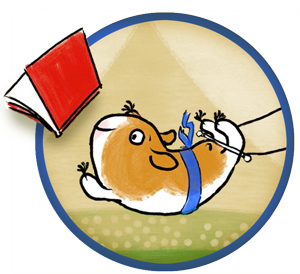PREORDER GIVEAWAY

NOTE: During the month of June, I’m running a special giveaway for people who preorder DOZENS OF DOUGHNUTS, which publishes July 21. Everyone who preorders gets something, and can also win a special pretend-play prize pack for your classroom or for a little baker in your life: an adorable apron just like the main character, LouAnn, wears; a dozen fleece mini doughnuts to play with; and doughnut hand stamps & stickers. Use this link to enter by June 30: https://www.carriefinison.com/giveaway
When my daughter was about four, we read the fantastic picture book Bee Bim Bop by Linda Sue Park. My daughter was intrigued, not only by the lively rhythms of the text, but also by the recipe in the back of the book. Of course, we had to try it! There’s something about reading a picture book about food that can entice even the pickiest eater to want to try something new, and it’s extra fun when a recipe is included.
As I worked on writing DOZENS OF DOUGHNUTS, I knew I wanted to develop a doughnut recipe to go with the story. But I had no idea where to begin. I’ve always enjoyed baking, but only as a home cook. Would I need to take a Johnson and Wales correspondence class before I could put a recipe in my book?
After talking with writer friends and researching online, it turns out that you don’t have to reinvent the wheel (or the recipe for doughnuts) in order to develop a recipe to go with your book. Below are some tips based on what I learned along the way.
1. Recipes can’t be copyrighted.
According to the US Copyright Office, the list of ingredients for a recipe cannot be copyrighted. However, the explanation and exact wording of the directions can be, so it’s important not to plagiarize and to restate things in your own words. Here’s the statement from Copyright.gov:
“A mere listing of ingredients is not protected under copyright law. However, where a recipe or formula is accompanied by substantial literary expression in the form of an explanation or directions, or when there is a collection of recipes as in a cookbook, there may be a basis for copyright protection. Note that if you have secret ingredients to a recipe that you do not wish to be revealed, you should not submit your recipe for registration, because applications and deposit copies are public records. See Circular 33, Works Not Protected by Copyright.”
Here’s a link to an article with more detail about copyright and recipes: https://www.davidlebovitz.com/recipe-attribution/
2. Look online and in cookbooks for several variations of your recipe.
There are MANY doughnut recipes out there. Some doughnuts are made with yeast and some are more cake-like. Some are fried and some are baked. I searched many recipes online and in classic cookbooks like The Joy of Cooking to come up with five to six different recipes to try.
3. Consider your audience.
I wanted my recipe to be kid-friendly. That’s hard to do with doughnuts, which are somewhat difficult to make, especially when deep-frying is involved. I thought baked doughnuts might be safer and easier. However, after testing MANY recipes for baked doughnuts, I realized they just don’t hold a candle to the fried version. Baking doughnuts also requires special equipment: a doughnut pan, which most people don’t have. Fried doughnuts (with the help of an adult) seemed more approachable. It’s also what my main character, LouAnn, does, so it’s more true to the book.
Here’s one attempt at baking doughnuts. I even tried making doughnut muffins.
Similarly, yeast doughnuts require a long rise time—difficult for children with their short attention span. I wanted a recipe that could be made quickly without rise time. Ultimately, I settled on cake-like doughnuts that are fried in a small amount of oil.
Here’s a good guide I found to kids’ cooking skills at different ages: https://www.bbcgoodfood.com/howto/guide/guide-cookery-skills-age
Fried doughnuts are the way to go!
4. Think about variations.
These days, many kids have allergies or special dietary concerns. If your recipe contains a common allergen, especially tree nuts or peanuts, consider recommending a substitution.
Here’s a website that can help you find substitutions for common food allergens in recipes: https://www.kidswithfoodallergies.org/recipe-substitutions.aspx
5. Put your own spin on it.
Even though copyright law allows you to copy someone else’s ingredient list, I wanted to put my own spin on my doughnut recipe. That meant making many batches with a variety of spices, and changing up some of the liquid ingredients. My family didn’t seem to mind! And in the end, having a recipe that’s truly my own makes me feel better.
6. Give credit where it’s due.
If you use a source for your recipe, give credit to the original source. I found my base doughnut recipe on the New York Times website, so I put the simple line, “Adapted from NYT Cooking” on my recipe.
7. Be aware of your page count.
Most likely, you’ll need to keep your recipe simple enough to fit on one page (or a spread at the most) at the back of your book.
As it turned out, my book, even at 40 pages, did not have enough space in the back for a recipe. But, I was able to salvage that work and now plan to use the recipe as a giveaway.
And so, without further ado, I’m sharing LouAnn’s doughnut recipe below. I hope that you and your kids enjoy making them as much as I did. If you do end up making some, hop over to my website and use the contact form to let me know. I’d love to see your creations!
Carrie Finison writes picture books with humor and heart, including DOZENS OF DOUGHNUTS (2020) and the forthcoming books DON'T HUG DOUG (2021) and HURRY, LITTLE TORTOISE (2022). She lives in the Boston area with her family. Find her online at www.carriefinison.com or on Twitter @CarrieFinison.





